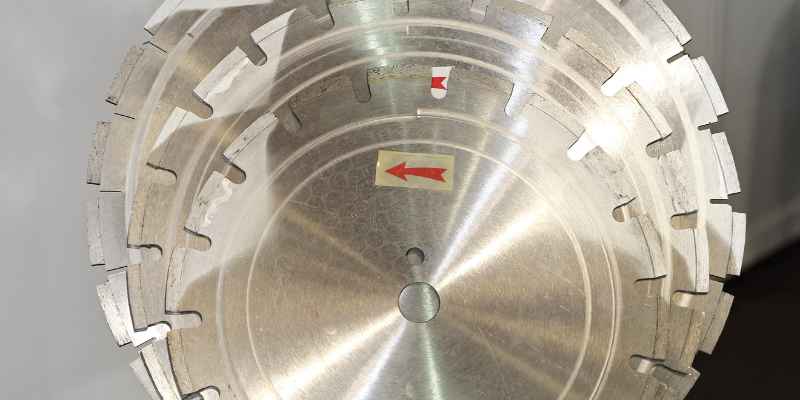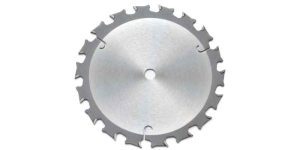Table saw blades are either reverse threaded or standard threaded depending on which side of the saw the blade is on. If the blade is on the left, the bolt is reverse threaded, and if the blade is on the right, it’s standard threaded.
Changing a table saw blade can be a daunting task, especially if you’re unsure about the direction in which the blade is threaded. Table saw blades can either be reverse threaded or standard threaded depending on which side of the saw the blade is on.
If the blade is on the left, the bolt is reverse threaded, and if the blade is on the right, it’s standard threaded. It’s essential to understand the threading direction to remove or replace the blade without damaging the saw. We’ll explore the threading direction of table saw blades and provide detailed instructions on how to change them safely.
How To Determine If Table Saw Blades Are Reverse Threaded
Determining if table saw blades are reverse threaded depends on their position. If the blade is on the left, the bolt is reverse-threaded, and if it’s on the right, it’s standard. To loosen the bolt, turn it to the right for left-sided blades and lefty-loosey for right-sided blades.
a Table Saw Blade and Determine if it’s Reverse Threaded
Table saws are a staple in any woodworker’s workspace. While changing the blade might seem like a simple task, there is a lot to consider, especially when it comes to the direction of rotation and blade replacement. A common question many woodworkers ask is whether table saw blades are reverse threaded or not. In this article, we will discuss how to determine if your table saw blade is reverse threaded and provide you with essential tips for changing your table saw blade.
Direction of Blade
When changing a table saw blade, you need to pay attention to the direction of the blade. This is particularly important when it comes to loosening the bolt that holds the blade in place. If the blade is on the left side of the saw, then the bolt is reverse-threaded, meaning you need to turn it to the right to loosen it. However, if the blade is on the right side of the saw, then the bolt is standard, and you need to turn it left to loosen it.
Left Side vs. Right Side Blades
As previously mentioned, the direction of the blade depends on which side of the saw it is on. Therefore, it’s essential to know the left and right sides of your table saw. Most saws are designed to have the blade placed on the left side of the saw, making it more comfortable for right-handed individuals to make cuts. However, some saws have the blade placed on the right side, making it easier for lefties.
To determine the left and right sides of your table saw, stand at the back of the saw and look at it from behind. The blade should be on the left side of the saw. If it’s on the right, then you have a saw designed for a left-handed person.
How to Determine if Table Saw Blades are Reverse Threaded
Another way to determine whether your table saw blade is reverse threaded is to look at the manufacturer’s instructions or manual that came with your saw. It’s not uncommon for manufacturers to include information on the direction of rotation and bolt removal procedure.
Additionally, you can inspect the bolt itself to see if it’s reverse-threaded or not. You can do this with a wrench and by turning it in a counterclockwise motion. If the bolt loosens up by turning to the right, then it is reverse-threaded. On the other hand, if it loosens up by turning to the left, then it’s standard threaded.
In conclusion, determining if your table saw blade is reverse-threaded is crucial for safely and effectively changing it. Remember to check the direction of the blade and inspect the bolt for the threading to avoid damaging your saw. Knowing how to change a table saw blade correctly can help you achieve excellent woodworking results without any hitches.
Ways To Change A Table Saw Blade
The direction to change a table saw blade depends on where it’s positioned. If the blade is on the left, then the bolt is reverse-threaded and needs to be turned to the right to loosen. If positioned on the right, lefty-loosey works.
Always unplug the saw and follow safety precautions before changing the blade.
Tools Required
To change a table saw blade, you will need a few tools on hand. These include the following:
- Table Saw wrench: the wrench that comes with your saw to adjust the blade
- Protective Gloves: prevents cuts and injuries
- Eye Protection: keep your eyes safe from flying debris
Steps Involved
Follow these simple steps to change a table saw blade:
- Unplug the saw to ensure your safety before starting
- Remove the Throat Plate and Blade Guard
- Raise the Blade
- Loosen Arbor Nut
- Use a Blade Lock or a Wrench and a Block of Wood to loosen and remove the old blade from the saw arbor
- Clean the Saw Arbor and Flanges and then Inspect the Blades for any damages or wear
- Install a new Blade onto the Saw Arbor.
- Use a blade lock or tighten the arbor nut with a wrench and a block of wood until it is secure
- Reinstall the Blade Guard and Throat Plate
- Finally, double-check everything is secure and then plug it back in the power source.
Are Table Saw Blades Reverse Threaded?
The bolt removal direction actually depends on which side of the saw the blade is on. If the blade is on the left, the bolt is reverse-threaded, and you need to turn it to the right for loosening. If the blade is on the right, it’s standard, and lefty-loosey works.
Remember, changing a table saw blade can be dangerous. Always ensure that you are wearing protective gloves and eye protection while performing this task. So, follow the steps properly, and you’ll be able to change your table saw blade efficiently.
Safety Measures To Follow While Changing Table Saw Blades

When changing the table saw blades, it’s important to ensure safety measures are followed. One important factor to consider is whether the blades are reverse threaded or not, as the direction of blade removal depends on which side of the saw it is on.
It’s also essential to unplug the saw and use a block of wood to prevent accidental blade rotation.
Importance Of Safety Measures
Table saws are powerful tools that make working with wood much easier and efficient. However, they can also be extremely dangerous if not handled properly. Changing blades on a table saw can be intimidating for those who are not familiar with the process. It’s crucial to follow proper safety measures to avoid any accidents.
Safety Tips
Here are some safety tips to follow while changing table saw blades:
- Disconnect the saw: Before attempting to change the blade, make sure to turn off and unplug the table saw from the power source.
- Use the right blade: Choose the right blade for the task and ensure that it’s compatible with your table saw.
- Check the arbor nut: Make sure that the arbor nut is securely in place and tightened properly to prevent the blade from wobbling.
- Protective gear: Always wear protective gear such as safety glasses and gloves while changing the blade.
- Read the manual: Always read the manufacturer’s instructions before attempting to change the blade.
- Keep the blade stable: Use a blade-locking mechanism to keep the blade stable while changing it.
- Use the right tools: Use the right tools, such as a wrench or pliers, to tighten or loosen the blade.
- Don’t over-tighten: Don’t over-tighten the blade to prevent damage to both the blade and the table saw.
- Inspect the blade: Before using the saw, inspect the blade carefully to make sure it’s aligned properly and free of any defects or damage.
Remember, taking proper safety measures while changing your table saw blade can prevent accidents and keep you safe while working with your saw. Stay alert and focused and make sure to follow the manufacturer’s instructions to prevent any mishaps.
Tips And Techniques To Make Changing Table Saw Blades Easy
If you’re wondering whether table saw blades are reverse threaded, the answer is yes – but it depends on which side of the saw the blade is on. If it’s on the left, the bolt is reverse-threaded and you need to turn it to the right for loosening.
If the blade is on the right, it’s standard and lefty-loosey works. Check out various YouTube tutorials to learn how to change table saw blade safely and easily.
As a woodworker, one of the most important maintenance tasks to ensure accurate and safe cuts is changing the table saw blades. It not only sharpens the blades to perfection but also extends their lifespan. However, changing blades can be overwhelming, especially if you are a beginner. Here are some tips and techniques you can use to make changing table saw blades a breeze:
Avoiding over-tightening Blades
Over-tightening blades can result in various issues, such as causing the blade to rotate off-center or even leading to the arbor thread stripping. To avoid over-tightening the blade, use a torque wrench and follow the manufacturer’s recommended torque specifications. This will prevent you from applying too much force and causing unnecessary problems.
Removing the Blade Safely
Removing the blade is another crucial aspect of blade changing. Safety should always be a top priority when working with power tools. Always make sure you unplug the saw, and never attempt to remove the blade with your hands. Some saws come with blade lock mechanisms to hold the blade stationary. If your saw doesn’t have this feature, a simple way to stop the blade from spinning is to wedge a piece of scrap wood between the blade and the throat plate.
Here is a table outlining the steps to change a table saw blade:
| Steps | Directions |
|——-|————|
| 1 | Unplug the saw |
| 2 | Remove the throat plate and blade guard |
| 3 | Raise the blade to its highest position |
| 4 | Loosen the arbor nut using the appropriate wrench |
| 5 | Remove the old blade |
| 6 | Install the new blade |
| 7 | Tighten the arbor nut to the recommended torque specification |
| 8 | Replace the throat plate and blade guard |
It’s important to note that some blades may require additional steps, such as using blade stabilizers or shims.
In conclusion, changing table saw blades can be overwhelming, but it’s a vital task for any woodworking project. By following the manufacturer’s instructions and using the tips and techniques discussed above, you can make the process simple and safe.
Common Issues When Changing Table Saw Blades
When changing table saw blades, one common issue people encounter is determining if the blades are reverse threaded. This depends on which side of the saw the blade is on, as the rotation direction for loosening the bolt differs. Paying attention to the blade’s placement and following proper safety procedures can help overcome this challenge.
Table saws are an essential part of any woodworking arsenal, and changing out blades is a necessary task. However, mishaps can occur during this process, causing frustration and even potential injuries. Here are some common issues that people run into when changing table saw blades along with ways to solve them.
Solving Blade Nut Issues
One of the most frustrating issues when changing table saw blades is dealing with the blade nut. If the nut is too tight, it can be challenging to loosen it. Conversely, if it’s too loose, it can cause the blade to wobble and affect your cuts’ precision. To solve this issue, it’s important to use the right wrench size, ensuring a secure and snug fit on the nut. If the nut is stuck, try using a penetrating oil to loosen it. Additionally, a blade locking mechanism or a block of wood can help keep the blade from moving while you’re removing the nut.
Loosening Stuck Blades
Another common issue is dealing with stuck blades. If a blade is stuck, it can be tempting to force it out. However, this can cause damage to your saw or the blade itself. To avoid this, you can use a blade removal tool or put some pressure on the blade’s center while loosening the nut. Additionally, using a lubricant such as WD-40 can help free up the blade.
Overall, changing a table saw blade can be a daunting task, but with the proper tools and knowledge, it doesn’t have to be. By addressing common issues such as blade nut problems and stuck blades, you can ensure a smooth and safe blade-changing experience. Remember to always prioritize safety and be patient when dealing with these challenges, and your table saw will continue to serve you well for years to come.

Frequently Asked Questions For Are Table Saw Blades Reverse Threaded
Are Saw Blades Reverse Threaded?
Yes, the bolt removal direction for saw blades depends on which side of the saw the blade is on. If the blade is on the left, the bolt is reverse-threaded, and you need to turn it to the right for loosening.
If the blade is on the right, it’s standard, and lefty-loosey works.
Which Way Does A Table Saw Blade Loosen?
If the arbor enters the blade from the left side of the saw (which is usually the case), you need to rotate the top of the nut toward you to loosen it and away from you to tighten. The bolt is reverse-threaded when the blade is on the left, and lefty-loosey works when the blade is on the right.
How Do You Remove A Saw Blade From A Table Saw?
To remove a saw blade from a table saw, start by unplugging the saw and removing the throat plate and blade guard. Raise the blade, loosen the arbor nut (turn right if on the left side, turn left if on the right side), and remove the old blade.
Then, install the new blade and securely tighten the arbor nut before reattaching the guard system and throat plate.
Is A Table Saw Nut Reverse Thread?
Yes, the table saw nut is reverse threaded if the blade is on the left side of the saw. You need to turn it to the right to loosen it. If the blade is on the right, it’s standard and lefty-loosey works.
Conclusion
Changing a table saw blade can seem tricky, and you might get confused about which direction to turn the bolt to remove the blade. However, after thorough research, we can confirm that whether a table saw blade is reverse threaded or not depends on the side of the saw the blade is on.
Therefore, you need to turn the bolt to the right to loosen it if the blade is on the left and if it’s on the right, you turn it to the left. By following these simple steps, you can change your table saw blade and continue your woodworking projects.


